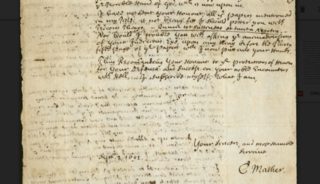 W
WThe Salem witch trials were a series of hearings and prosecutions of people accused of witchcraft in colonial Massachusetts between February 1692 and May 1693. More than two hundred people were accused. Thirty were found guilty, nineteen of whom were executed by hanging. One other man, Giles Corey, was pressed to death for refusing to plead, and at least five people died in jail.
 W
WAndover is a town in Essex County, Massachusetts, United States. It was settled in 1642 and incorporated in 1646. As of the 2010 census, the population was 33,201. It is part of the Boston-Cambridge-Quincy, Massachusetts-New Hampshire metropolitan statistical area. Part of the town comprises the census-designated place of Andover. It is twinned with its namesake: Andover, Hampshire, England.
 W
WBloodlines of Salem is a Salt Lake City-based family-history group in the United States of America. Its purpose was described as providing a "place where visitors share ideas and information about the Salem witch trials of 1692, its participants and their families. Many visitors have researched and proved their descents from one or more of the participants. The trials unfolded more than three centuries ago and continue to figure prominently in the studies of history, law and religion. As amateur and professional researchers, or 'Salemologists,' however, their study of the trials isn't limited to their lineages."
 W
WThe Bury St Edmunds witch trials were a series of trials conducted intermittently between the years 1599 and 1694 in the town of Bury St Edmunds in Suffolk, England.
 W
WDanvers is a town in Essex County, Massachusetts, United States, located on the Danvers River near the northeastern coast of Massachusetts. The suburb is a fairly short ride from Boston and is also in close proximity to the renowned beaches of Gloucester and Revere. Originally known as Salem Village, the town is most widely known for its association with the 1692 Salem witch trials. It was also the site of Danvers State Hospital, one of the state's 19th-century psychiatric hospitals. Danvers is a local center of commerce, hosting many car dealerships and the Liberty Tree Mall. As of 2014, the town's population was approximately 27,000.
 W
WThe John Hale House, also known as the Rev. John Hale Farm, is a historic Colonial house located at 39 Hale Street, Beverly, Massachusetts. The house is now operated as a nonprofit museum by Historic Beverly, with period furnishings and a room containing witchcraft-related artifacts.
 W
WThis is a list of people associated with the Salem Witch Trials, a series of hearings and prosecutions of people accused of witchcraft in colonial Massachusetts between March 1692 and May 1693. The trials resulted in the executions of twenty people, most of whom were women.
 W
WThe Rebecca Nurse Homestead is a historic colonial house built ca. 1700 located at 149 Pine Street, Danvers, Massachusetts. It had many additions through the years, eventually being historically restored and turned into a museum in 1909. Today it is owned and operated by the Danvers Alarm List Company, a volunteer non-profit organization.
 W
WIn a letter dated September 2, 1692, Cotton Mather wrote to judge William Stoughton. Among the notable things about this letter is the provenance: it seems to be the last important correspondence from Mather to surface in modern times, with the holograph manuscript not arriving in the archives for scholars to view, and authenticate, until sometime between 1978 and 1985.
 W
WSalem is a historic coastal city in Essex County, Massachusetts located in the North Shore region. Continuous settlement by Europeans began in 1626 and Salem would become one of the most significant seaports in early American history.
 W
WThe Witch History Museum is located in Salem, Massachusetts and features dioramas and first person narrations, including little-known information about nineteen accused "witches" that were put to death in 1692. The museum covers the hysteria surrounding the events.
 W
WThe Jonathan Corwin House in Salem, Massachusetts, known as The Witch House, was the home of Judge Jonathan Corwin (1640–1718) and is the only structure still standing in Salem with direct ties to the Salem witch trials of 1692, thought to be built between 1620 and 1642. Corwin bought it in 1675 when he was 35, and he lived there for more than 40 years; the house remained in the Corwin family until the mid-19th century. It is located at 310 Essex Street at the intersection of North Street and Summer Street in the McIntire Historic District.